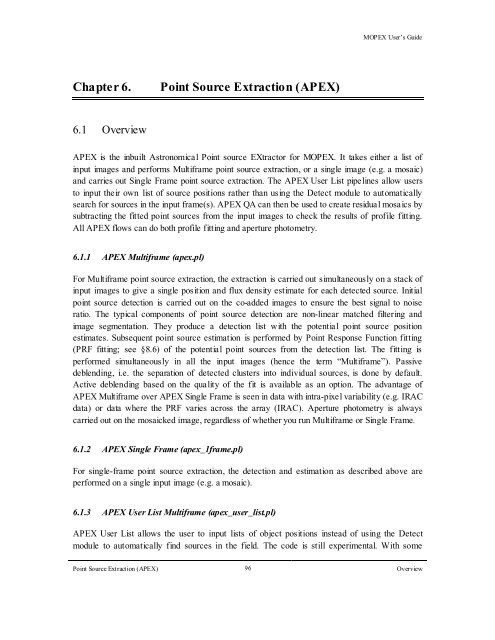Create successful ePaper yourself
Turn your PDF publications into a flip-book with our unique Google optimized e-Paper software.
Chapter 6. Point Source Extraction (APEX)<br />
6.1 Overview<br />
<strong>MOPEX</strong> User’s <strong>Guide</strong><br />
APEX is the inbuilt Astronomical Point source EXtractor for <strong>MOPEX</strong>. It takes either a list of<br />
input images and performs Multiframe point source extraction, or a single image (e.g. a mosaic)<br />
and carries out Single Frame point source extraction. The APEX User List pipelines allow users<br />
to input their own list of source positions rather than using the Detect module to automatically<br />
search for sources in the input frame(s). APEX QA can then be used to create residual mosaics by<br />
subtracting the fitted point sources from the input images to check the results of profile fitting.<br />
All APEX flows can do both profile fitting and aperture photometry.<br />
6.1.1 APEX Multiframe (apex.pl)<br />
For Multiframe point source extraction, the extraction is carried out simultaneously on a stack of<br />
input images to give a single position and flux density estimate for each detected source. Initial<br />
point source detection is carried out on the co-added images to ensure the best signal to noise<br />
ratio. The typical components of point source detection are non-linear matched filtering and<br />
image segmentation. They produce a detection list with the potential point source position<br />
estimates. Subsequent point source estimation is performed by Point Response Function fitting<br />
(PRF fitting; see §8.6) of the potential point sources from the detection list. The fitting is<br />
performed simultaneously in all the input images (hence the term “Multiframe”). Passive<br />
deblending, i.e. the separation of detected clusters into individual sources, is done by default.<br />
Active deblending based on the quality of the fit is available as an option. The advantage of<br />
APEX Multiframe over APEX Single Frame is seen in data with intra-pixe l variability (e.g. IRAC<br />
data) or data where the PRF varies across the array (IRAC). Aperture photometry is always<br />
carried out on the mosaicked image, regardless of whether you run Multiframe or Single Frame.<br />
6.1.2 APEX Single Frame (apex_1frame.pl)<br />
For single-frame point source extraction, the detection and estimation as described above are<br />
performed on a single input image (e.g. a mosaic).<br />
6.1.3 APEX User List Multiframe (apex_user_list.pl)<br />
APEX User List allows the user to input lists of object positions instead of using the Detect<br />
module to automatically find sources in the field. The code is still experimental. With some<br />
Point Source Extraction (APEX) 96<br />
Overview





